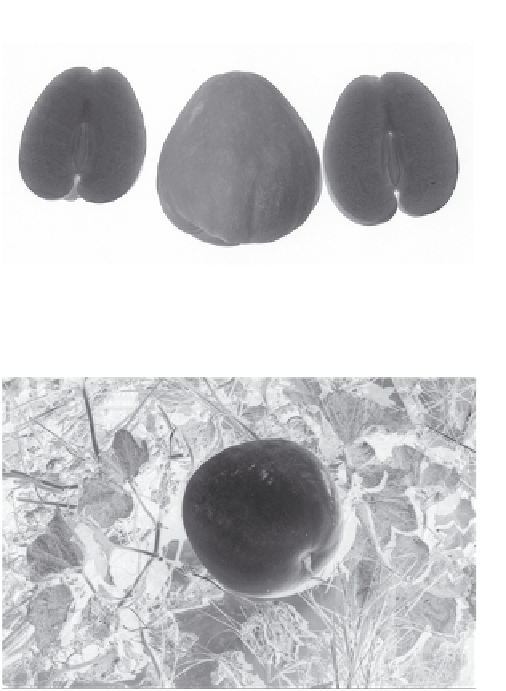Agriculture Reference
In-Depth Information
withstand rain during production. China and India are the
greatest producers by far. However, wax gourds can be
found throughout Asia as well as in locations wherever
there are people of Asian descent.
Wax gourd is the only cultivated cucurbit within
the genus
Benincasa
and together with watermelon, bot-
tle gourd, luffa and lesser cucurbits is found in the Tribe
Benincasea. Wax gourd shares many characteristics with
Cucurbita
, the squashes, but differs in certain critical flower
characteristics, centres of origin and chromosome number.
The mostly round, but often irregularly shaped fruit are
produced at intervals along the trailing vines. The fruit may
be harvested when the waxy bloom is fully developed and
fruit have reached the desired weight, or they may be left
in the field until needed or until market conditions favour
harvest. The designation winter melon indicates successful
storage over an extended period.
As the plants grow, their young shoots and leaves may
be used as greens. The immature fruit may be used in ways
similar to summer squash. The mature fruit flesh can be
eaten as a vegetable or its seed cavity can be hollowed out
for use as a container for soup made with other vegetables,
fish, or meat. Because of its mild flavour, wax gourd is
complimented by many foods. The wax gourd often serves
as the centrepiece for festive occasions (Nayer & More
1998; Robinson & Decker-Walters 1997).
Figure 14.10
Chayote fruit and longitudinal section.
Figure 14.11
Wax gourd fruit.
World production
Melon and pumpkin, squash, gourd are each grown on
slightly over one million hectares worldwide producing
over 19 million tons and 15 million tons, respectively from
yields of about 17 000 kg/ha
−1
and 13 000 kg/ha
−1
, respec-
tively (Table 14.4). Watermelon is grown on almost 3 mil-
lion hectares with annual production exceeding 63 million
tons. Average yields exceed 21 000 kg/ha
−1
. Cucumber pro-
duction is intermediate between watermelon and that of
melon and pumpkin, squash and gourd (FAO, 2002).
Asia, by every measure, is the largest cucurbit producer
(Table 14.5). China is the leading country in production of
all cucurbits for which data are available. India is a major
pumpkin, squash, gourd producer and Japan is an important
producer of cucumber. Cucurbits are important in the Middle
East as well, with Turkey and Iran being centres of cucum-
ber, melon, and watermelon production. In Europe, Spain is
an important melon producer and Ukraine is a major squash
and pumpkin producer. The United States and Mexico are
the principal cucurbit producers in North America, and
Egypt holds that distinction in Africa (FAO 2002).
Certainly, cucurbits are important locally elsewhere in
the world. Historically, winter squash has been an important
The very long vines are supported on an overhead trellis
so workers can walk beneath the crop and easily identify
and harvest fruit ready for market. Fruit are transported,
sometimes via a miniature train system, to a packing
house for sorting and placement in shipping containers.
They are often wrapped in tissue paper to prevent bruising
of the tender skin.
The fruit is used as vegetable and is similar to scallop
summer squash in texture and flavour. Young shoots and
leaves as well as portions of the tubers also are used as
food. It is also used in the food industry as an ingredient
in sauces and fillings (Robinson & Decker-Walters 1997).
Wax gourd (
Benincasa hispida
)
Also known as Chinese winter melon, ash gourd, Chinese
preserving melon and other local names, the wax gourd
(Figure 14.11) is named for the white waxy bloom that
covers the fruit surface. Japan and Indonesia are thought
to be the centres of origin with India and Indochina being
the present day areas of greatest diversity. Wax gourd
thrives in areas with a long, warm growing season and will































